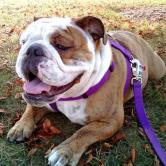Equipment You'll Need When Training Your Bulldog

You don’t have to walk into your Bulldog’s training alone – there is a variety of equipment available to use during your dog's training.
As with any training program, you should always start with the basics. As you see how your Bulldog responds to them, you’ll be better able to make decisions based your dog's successes rather than failures.
When you’re starting out with basic obedience training, you’ll need a simple flat buckling collar and a 4 to 6 foot leash. Look for a leash and collar that are double-stitched nylon that are sturdy, long-lasting, and machine-washable. If you can, avoid leather, as it shrinks and is easily chewed. On young puppies, you can use a harness, but avoid using them for long term use, as they may promote pulling. As well, avoid retractable leashes, as they encourage your dog to walk ahead of and lead you.
You may have heard of choke chains and prong collars. These tools are commonly used to give owners maximum control over their dogs quickly. You snap the choke collar to gain your dog's attention, and release it quickly to stop discomfort. Prong collars apply pressure where the prongs push into the dog's neck. And although prong collars look more torturous, they may actually be safer for your dog's trachea and spine than regular choke collars. Used and fitted properly, choke chains and prong collars may help you gain control over an unruly dog with little danger of physical harm. But this training is not meant for the long term, as control is forced more than good behavior is encouraged. You’ll have to consider how choke chains or prong collars fit in with your overall training strategy before using them.
Other training equipment options include head collars or head halters such as the Gentle Leader or Figure 8 Collar. These fit over your dog's head, and the leash is attached underneath the muzzle and work by controlling the directional movement of the dog's head. When the direction of the head is controlled, the body follows. Like choke and prong collars, this equipment raises concerns about forcing behavior and potentially creating resistance.
In our experience, dogs respond best to training that builds mutual respect between themselves and the owner. You will find that most Boston Terriers prefer to choose to behave, rather than being forced into submission. Because dogs respond to training collars and harnesses differently, never force your dog to use equipment it does not respond well to. Before you use a specially designed training collar or harness, be certain you know how to use it and make sure it properly fits your dog.
These types of equipment are temporary fixes to control or safety issues, rather than lifelong training solutions. Stay focused on the long-term goal, which is teaching your Boston Terrier to be a happy, enthusiastic learner.







